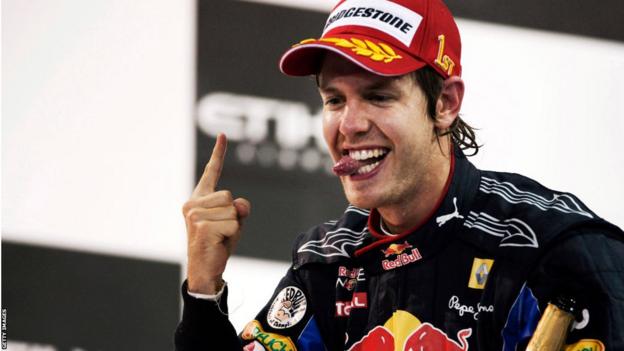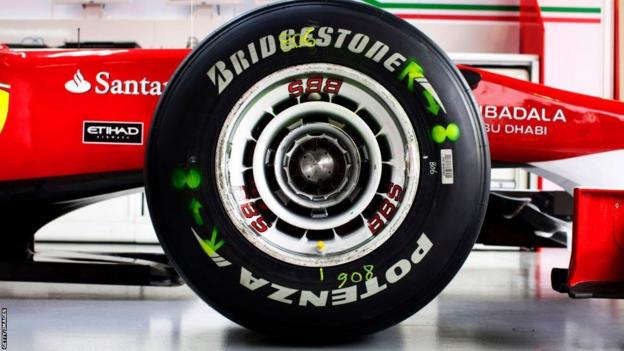
| Venue: Circuit Gilles Villeneuve, Montreal Dates: 16-18 June |
| Coverage: Live text commentary and radio commentary of all sessions on the BBC Sport website & app, with live commentary of the race on BBC Radio 5 Live and BBC Sounds app from 19:00 on Sunday. Full details |
Bridgestone has lodged a bid to become Formula 1’s tyre supplier from 2025.
Senior sources have told BBC Sport the tender document submitted is “impressive” and the Japanese company is being seriously considered as an option to replace Pirelli.
The Italian company, which has supplied F1 since 2011, wants to continue.
The drivers are aware of Bridgestone’s bid and some are supportive of the idea of it being F1’s new supplier as a result of frustrations with Pirelli.
Drivers have been urging Pirelli for years to produce a tyre that is less sensitive to overheating when pushed hard or trying to overtake.
Insiders say Bridgestone has pledged as part of its bid that it can produce a tyre on which drivers can push harder for longer.
Lewis Hamilton and Fernando Alonso are the only active drivers to have experience of driving on Bridgestone tyres in F1. They used them from 2007 to 2010, after which the company pulled out of F1.
A leading driver told BBC Sport that the two multiple champions have been vocal within the driver group in expressing their approval of the way Bridgestone tyres behaved when the company was last in F1, especially for the way they could drive flat out throughout grands prix without fear of the tyres overheating.
However, some senior figures are sceptical of the wisdom of changing supplier, saying Pirelli has been a loyal partner of F1 for more than a decade, has been effective and supportive, and there is no guarantee a replacement tyre company would do a better job.
Some point to the extreme demands put on tyres by modern F1 cars, which are of a different magnitude to those experienced in Bridgestone’s time in the sport from 1997 to 2010.
The cars are 200kg heavier than they were back then and produce significantly more downforce, meaning the forces imposed on tyres during cornering are significantly greater.
Others more supportive of a Bridgestone bid have told BBC Sport that there is no reason to believe a company with such a strong reputation in motorsport would have significant difficulty producing the tyres required.
Another complication is the relatively short timeframe involved.
Pirelli’s current contract runs out at the end of 2024, which gives a new manufacturer only 18 months to produce the equipment and logistical capacity to supply a season of 22 or more grands prix.
A source close to Bridgestone said one reason for the company’s interest in F1 could be the sport’s growth in the US market, where the company is keen to raise its profile.
Bridgestone already supplies the tyres to the US-based IndyCar series under its Firestone brand.
Bids from both Pirelli and Bridgestone have been received by the FIA. The governing body is conducting a technical assessment which is likely to conclude in the next few weeks before the companies enter commercial discussions with F1, which could take a few months.
As a commercial matter as well as a sporting one, no-one in F1 would talk to BBC Sport on the record about Bridgestone’s bid.
A Bridgestone spokesperson said: “Bridgestone has a 60-year heritage in motorsports and we are a partner in many motorsport events. We will continue to advance and refine our technologies through top-level races around the globe that require top-level tyre performance. F1 is considered as one of the various options.”
What have drivers said about tyres?
In the first part of this season, a number of drivers have spoken about the effect of the overheating of Pirelli tyres on overtaking.
Ferrari’s Carlos Sainz said: “As soon as you are behind a car and lose a bit of traction, a bit of braking grip, you start slipping the tyre and that extra slip means the next corner you have less grip and then you have a bit less and you are only able to follow for one or two laps, and then you have to back off.”
Aston Martin’s Fernando Alonso added: “The tyres still get overheated quite heavily if you follow cars. You need to decide wisely when you want to be too close to a car in front of you, so that’s the problem.”
The drivers acknowledge that Pirelli has improved this characteristic of the tyres over the years, and has made a further step following the introduction of lower-profile tyres on 18-inch wheels alongside new technical rules for the cars in 2022.
However, they say the fundamental issue of the tyres having to be managed to keep the temperature below a specific limit or suffer a significant loss of performance remains.
One driver pointed to the tyres used in endurance racing categories in Europe and the US.
The cars are slower, he admitted, but the Michelins used by many teams in sports cars can be driven hard for the entirety of their much longer races. They still drop in performance as they wear – a phenomenon known as degradation and a requirement of F1 tyres because of the need for pit stops – but do so while still allowing a driver to push to the limit.
Another said the drivers as a group were open to the idea of a new supplier but had no uniform position on which one it should be.
The other concern drivers have is the narrow working temperature range of the Pirelli tyres, and the fact that getting them into that window is difficult.
This can lead to drivers suffering a lack of performance for no other reason than being unable to fully understand the operating requirements for a tyre they believe is too sensitive and difficult to predict in this area.
What does Pirelli say?
Pirelli motorsport director Mario Isola told BBC Sport: “We just got the confirmation from the FIA that we are approved as a bidder and we can start the negotiations with F1.
“It is not a secret we want to continue. We want to continue to supply a tyre that is in line with the expectations of all the stakeholders.
“Sometimes it is difficult to agree with everybody because they have different positions.
“Drivers want one kind of tyre, F1 a different one. But in the past it was the same and we had many discussions with all the stakeholders to find the best compromise for the sport. I believe we have the same interests as the FIA and F1.
“I believe that especially with the 18-inch tyres we have delivered a good product, the drivers are happy.
“OK, sometimes there are complaints, but this is normal when you are a sole supplier.”
Asked for his response to drivers’ observations that tyre overheating behind other cars was still a significant factor in making overtaking more difficult than F1 wanted it to be with the new regulations, Isola said: “This is something we have to understand.
“Last year, with the new cars and the 18-inch tyres, I remember that the general comment was: ‘Much better. We don’t lose downforce. When we follow, we don’t have overheating’.
“So it’s a bit strange that with more or less all the compounds now they are complaining about overheating.”
Bridgestone’s history in F1

Bridgestone entered the sport in 1997 when competition between tyre companies was permitted – nowadays, a single supplier is mandated – and made an immediate impression against incumbent Goodyear.
Most famously, Damon Hill came close to winning the 1997 Hungarian Grand Prix in an uncompetitive Arrows before a car problem in the closing laps because his Bridgestones had a significant advantage over the Goodyears on the day.
McLaren, then a top team, switched to Bridgestones for 1998 and dominated the start of the season before Goodyear, which supplied rivals Ferrari, improved its product and Michael Schumacher was able to challenge McLaren’s Mika Hakkinen for the title before the Finn finally prevailed.
Ferrari switched to Bridgestones for 1999 before dominating F1 for five years against Williams and McLaren cars now running Michelins, after the French company entered F1 in 2000.
Michelin, which pulled out of F1 after 2006, has toyed with the idea of coming back to F1 a number of times over the years of Pirelli’s tenure but an agreement was never possible between the French company and F1.
Korean company Hankook, which supplies the all-electric Formula E series, bid the last time the tender was up for grabs but F1 preferred to stick with Pirelli.
At the time, Hankook was an outside bet as a company that had no significant experience at the highest level of motorsport.
Bridgestone’s bid comes from a company with a very different, much stronger reputation and marks the biggest threat to Pirelli’s tenure in the sport since it entered F1.


